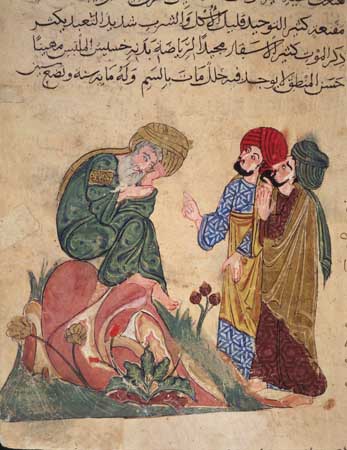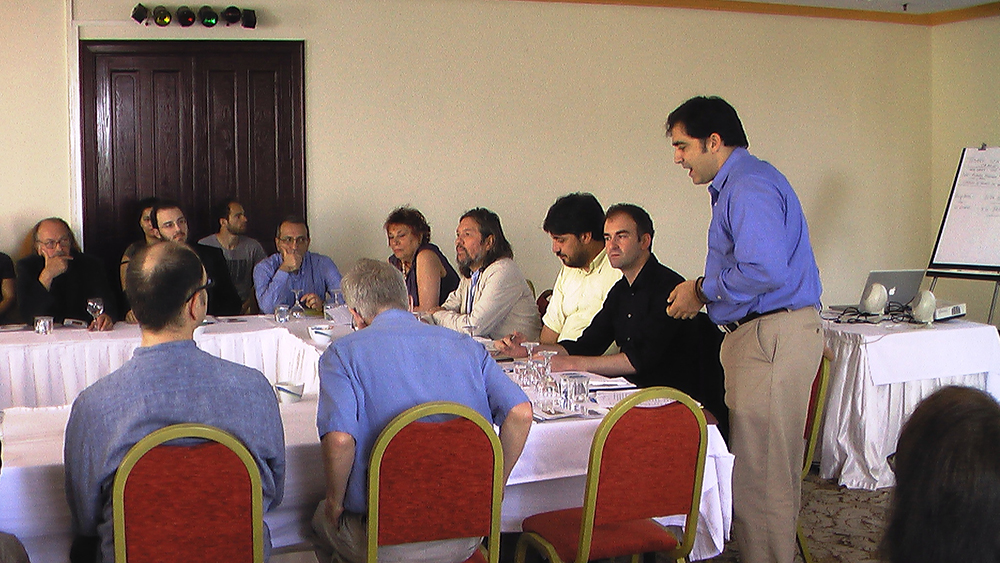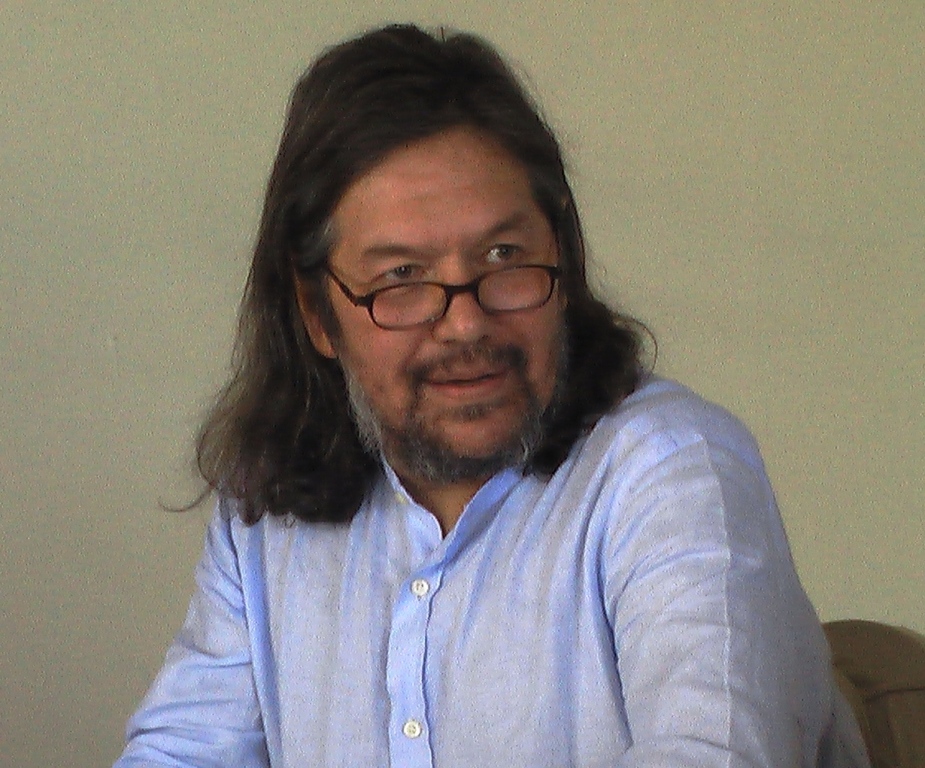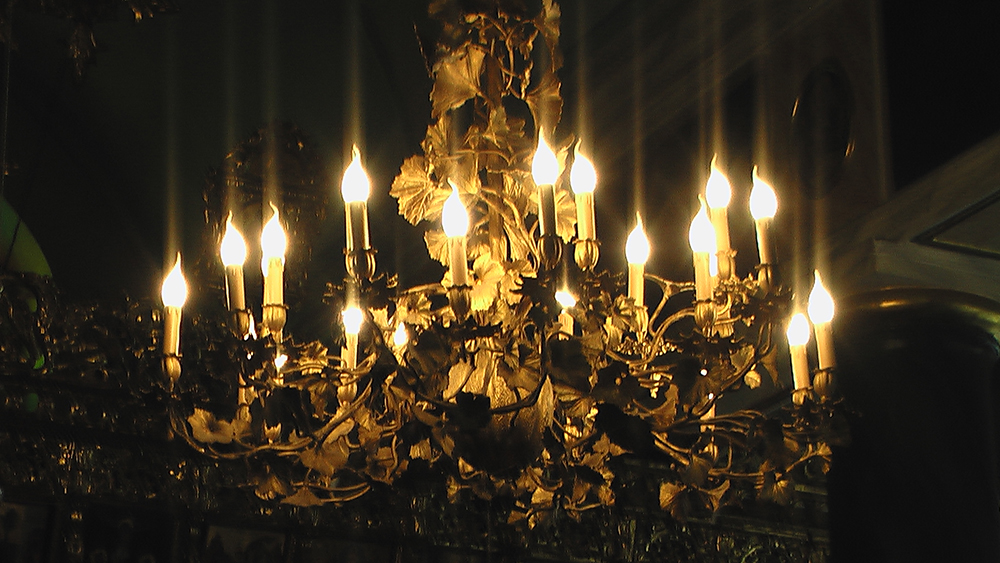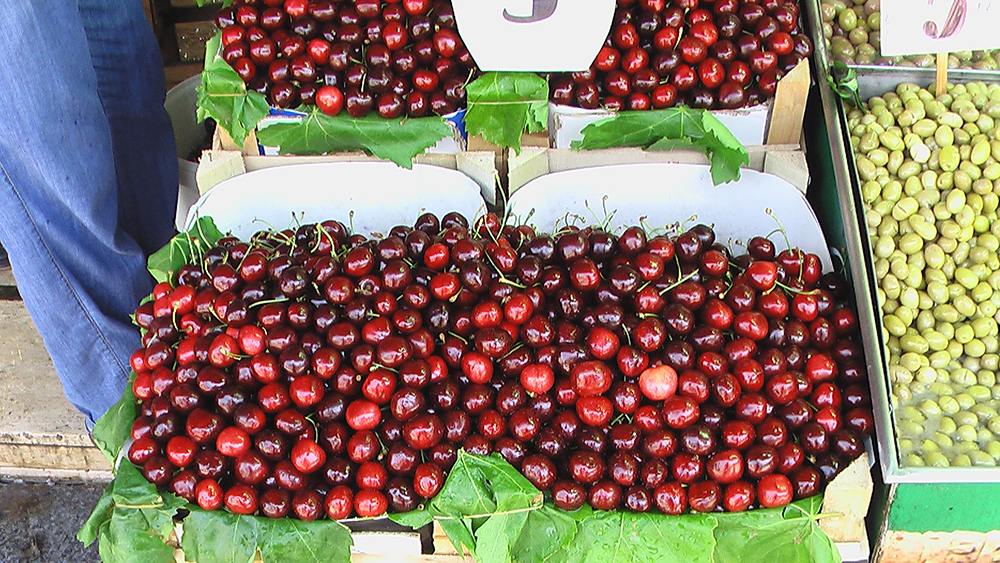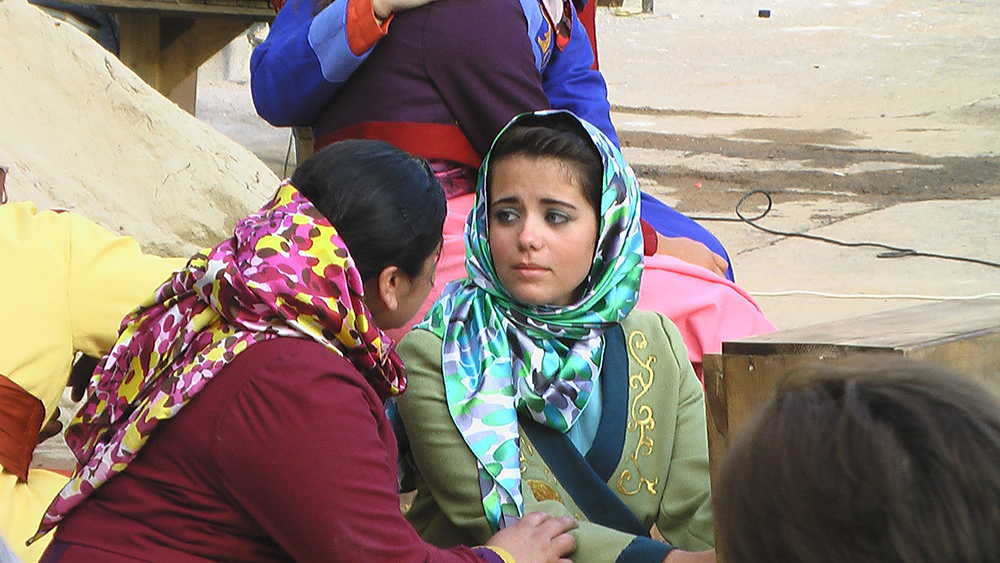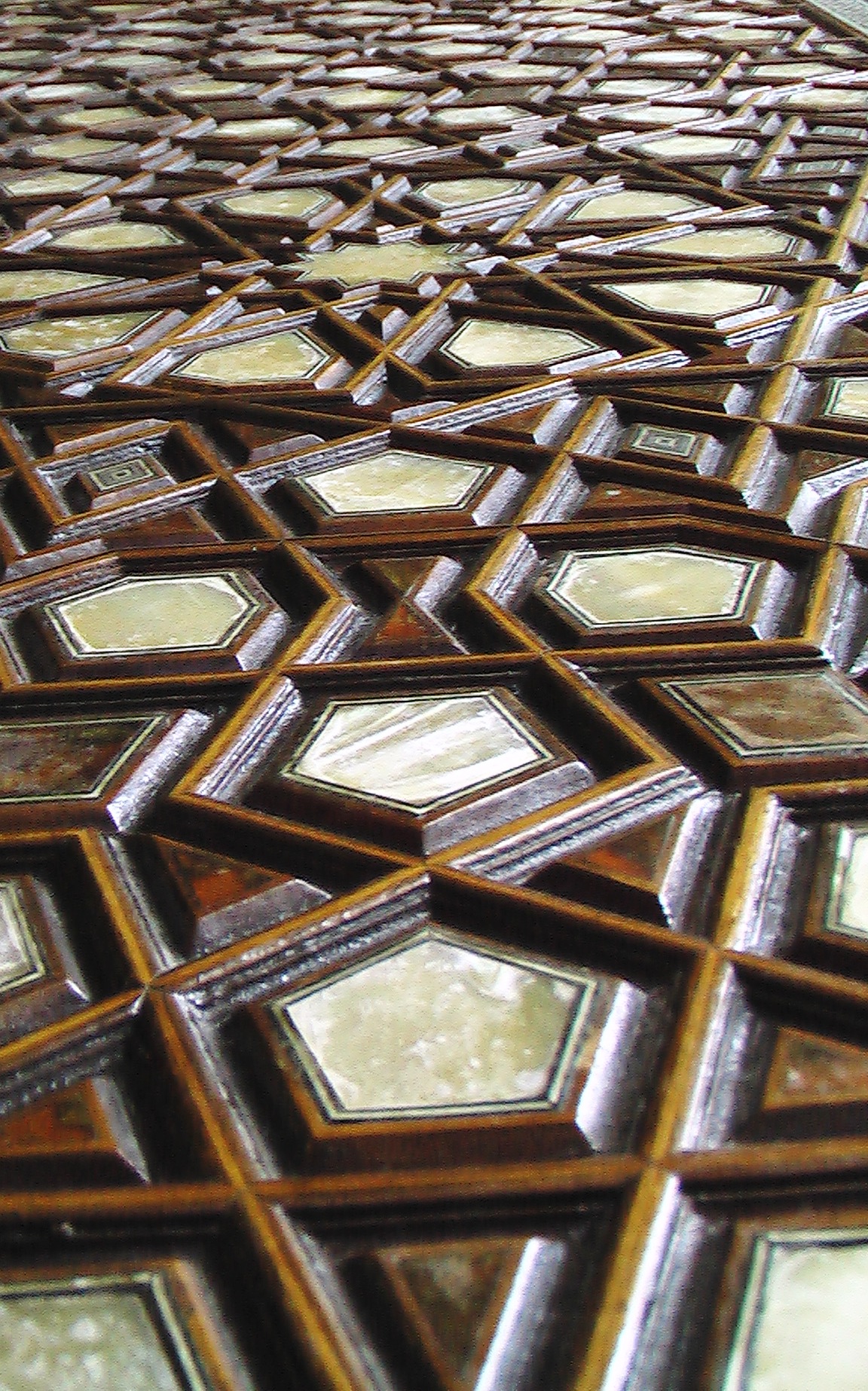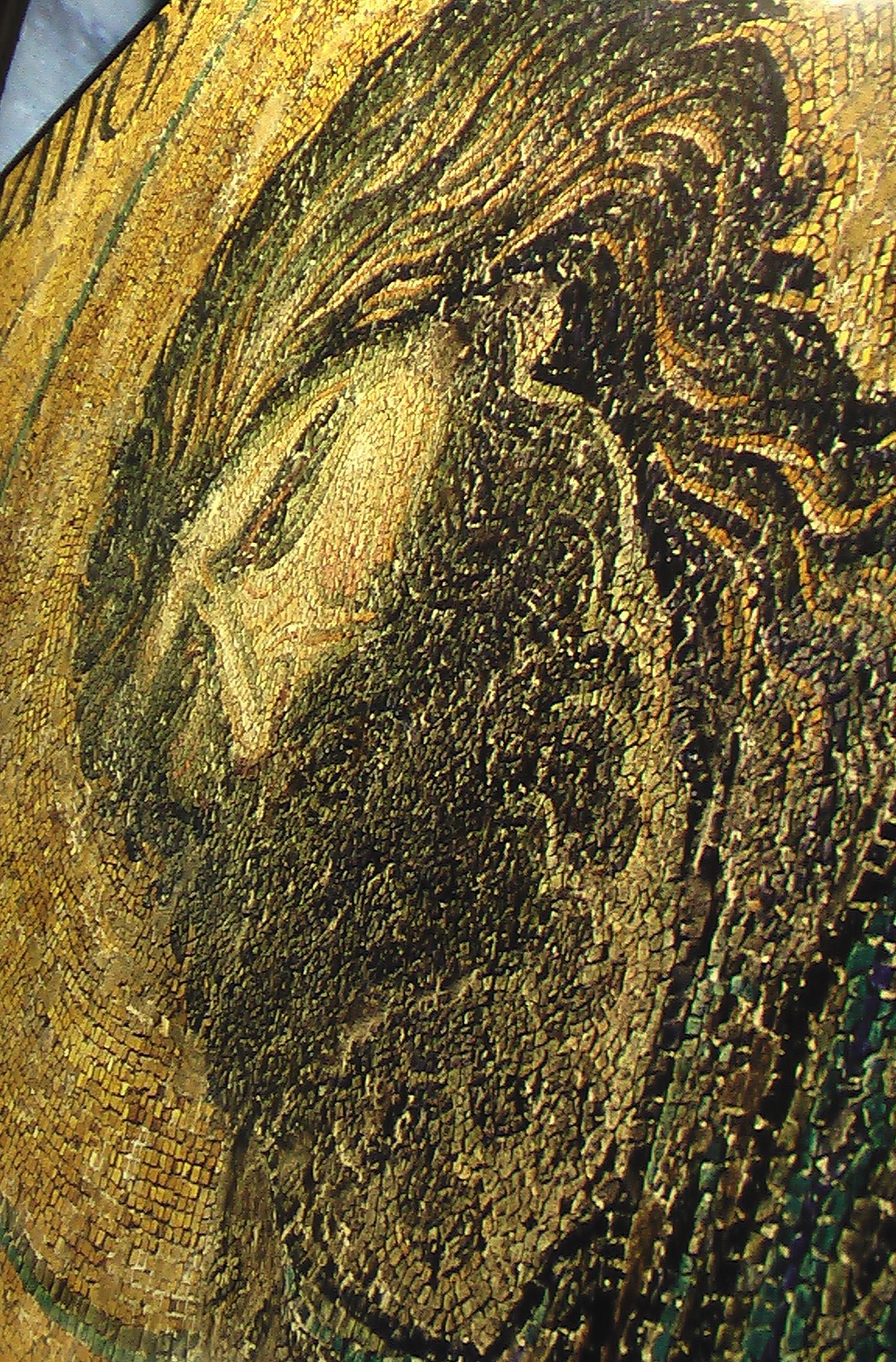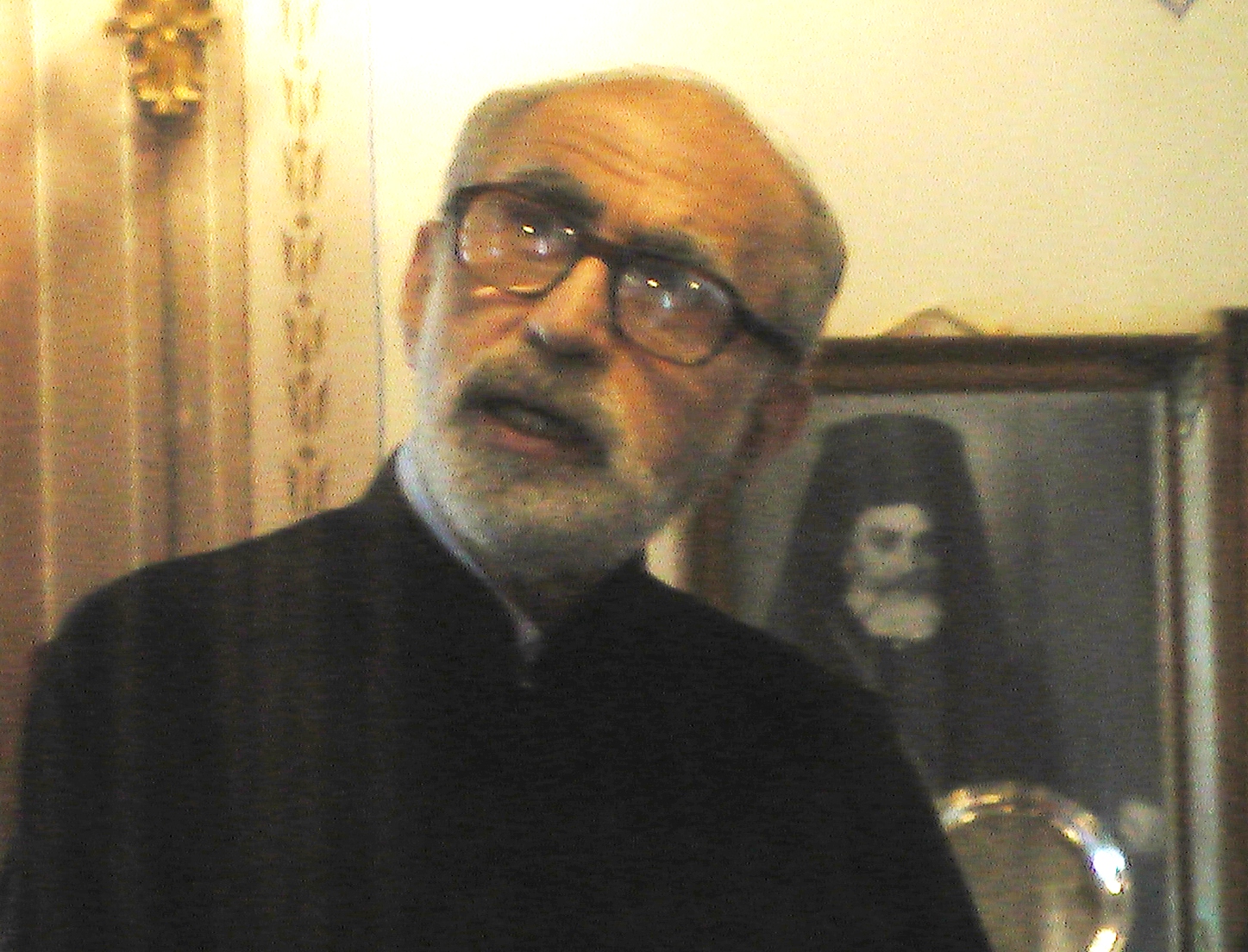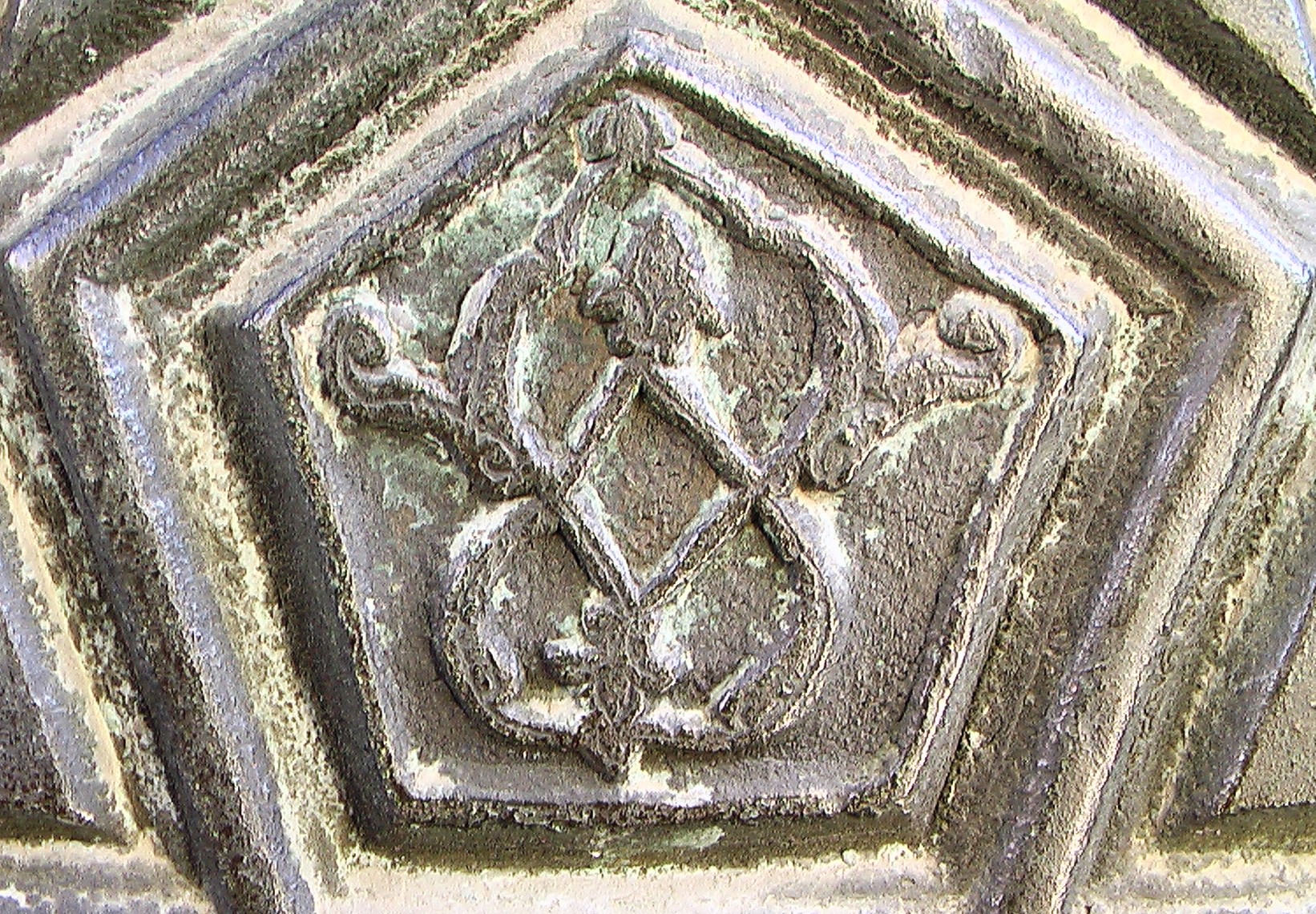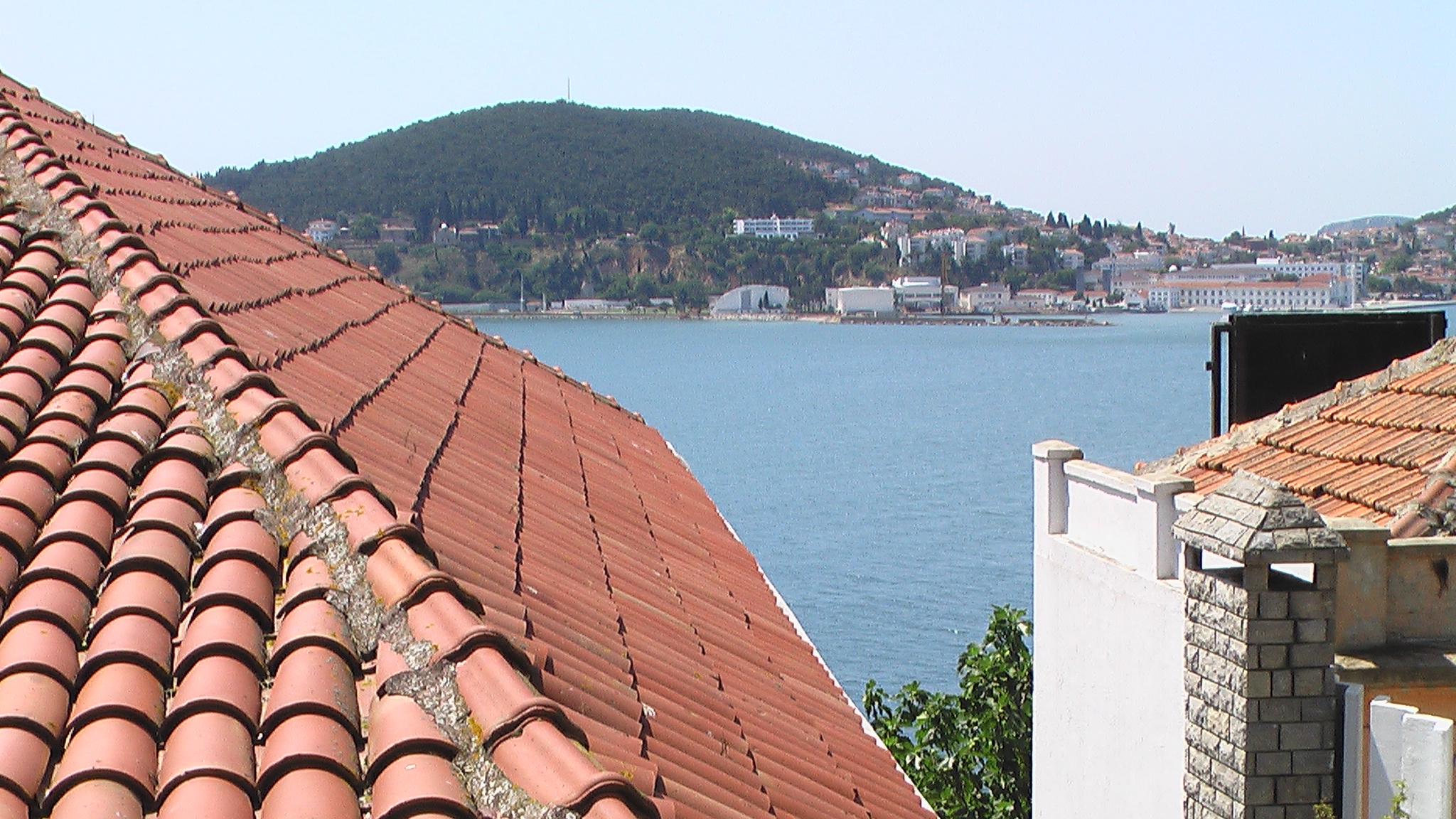Symposium in Istanbul 2010
I stanbul 2010: A Look Back
stanbul 2010: A Look Back
(Please click on the image to the right for a sampling of the music of Bosphorus, an
ensemble of Greek and Turkish musicians)
The second in a series of symposia hosted by the Interdisciplinary Center for Hellenic
Studies at Stockton University was held in Istanbul from June 9th through the 11th. It
followed a symposium in Delphi (2008) and was, by all accounts, a tremendous success.
It and the peripheral programs which included a concert, three play performances, a
tour of the Halki Theological School, a tour of Saint George's monstery on Prince's
Island, an informal and impromptu gathering with the General Consul of Greece in Istanbul
and much more took made for an unforgettable experience for the students, professors,
speakers and guests, who came from the US, Greece, Turkey and the UK.
While the editors will slowly begin to prepare the collected papers for publication,
we will, in the short term, try to fill you in on all that happened. In the coming
days, check back here for reflections on and photos of the unforgettable experiences
on the serene yet controversial island of Halki (Heybeliada) in the magnificent City.
Those of us who attended wish to express our deepest gratitude to our supporters,
funders, hosts and guests who made the endeavor possible and worthwhile.
Greek Orthodox (Rum Ortodoks) Religious Culture in Ottoman Anatolia: Monuments, Memory,
and Material Culture A Symposium to be held on Heybeliada, Istanbul- Turkey
June 9-12, 2010
Sponsored by the Interdisciplinary Center for Hellenic Studies
The Richard Stockton College of New Jersey
This international symposium will be the second organized by the ICHS of Stockton
College. In 2007, we conducted a successful literary symposium in Delphi, Greece
(American Experience of Delphi). The papers have been edited, and we are swiftly moving
towards publication by the ICHS and Somerset Hall Press to to be completed in 2010.
ICHS is able to offer you free accommodation, and breakfast at the Halki Palace Hotel
for the duration of the symposium. Unfortunately, at this time, no other travel expenses
are able to be offered. We will, however, make all necessary arrangements for airport
transfers to and from the Halki Palace Hotel including ferry rides.
Please feel free to contact us with any questions at ichs@stockton.edu.
The massive group trip to our symposium in Istanbul was the second of its kind for us (first was Delphi 2008). Arts and Humanities Assistant Dean, Nancy Messina was with us and fortunately kept track of all the goings on. What follows is her six-day report.
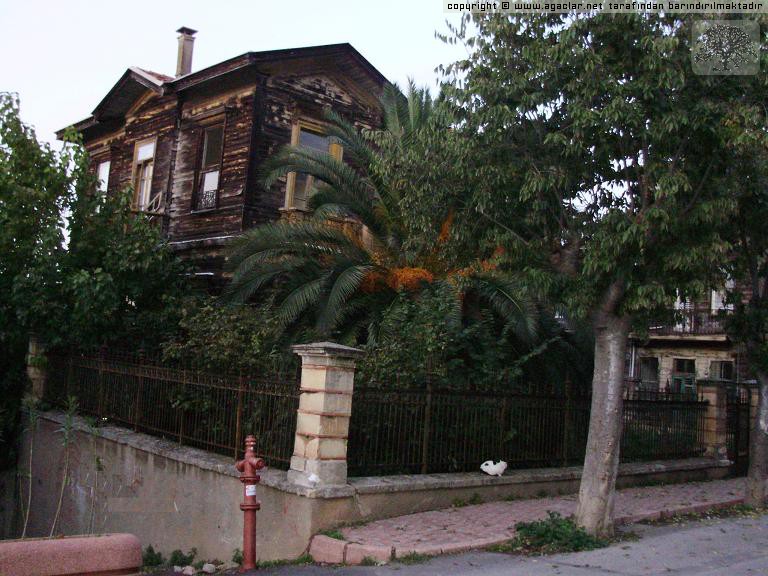 Well, thankfully we did not have a repeat of the 48 hour Greek Odyssey to Delphi.
Upon arrival in France, we made it to our connecting flight, after maneuvering through
the very slow transportation system and security at DeGaulle Airport, just in the
nick of time to board. Flights were good and I was very happy to report to Tom Papademetriou
that we made it to Istanbul. Tom arranged for the Stockton group to be met at the
airport and transported through Istanbul to the ferry. Once we got to the ferry,
it felt like we were almost home :) The 1 hour 15 minute ferry ride to Heybeliada
gave everyone in the group a chance to finally relax and just enjoy the ride.
Well, thankfully we did not have a repeat of the 48 hour Greek Odyssey to Delphi.
Upon arrival in France, we made it to our connecting flight, after maneuvering through
the very slow transportation system and security at DeGaulle Airport, just in the
nick of time to board. Flights were good and I was very happy to report to Tom Papademetriou
that we made it to Istanbul. Tom arranged for the Stockton group to be met at the
airport and transported through Istanbul to the ferry. Once we got to the ferry,
it felt like we were almost home :) The 1 hour 15 minute ferry ride to Heybeliada
gave everyone in the group a chance to finally relax and just enjoy the ride.
Upon arrival we were welcomed at the dock by a smiling Tom Papademetriou and David
Roessel.
Since there are no cars on the island, some of our luggage and members of the group
were taken in horse carriages up the very steep hill to The Halki Palace Hotel. A
few of us walked to the hotel and had a chance to take in many of the lovely old
buildings, some of which are being renovated. It is really quite beautiful here on
the island.
After a short break the group met in the hotel lobby and walked down the hill to have
dinner. Tom ordered a variety of different dishes for everyone to taste and we dined
outside by the water where everyone shared in their first taste of the local cuisine,
which was excellent. It was a perfect ending to a very long day of travel. It was
very interesting to notice how quiet it is here while walking back to the hotel after
dinner.
A very busy day. The Richard Stockton College Second International Symposium Greek
Orthodox (Rum Ortodoks) Religious Culture in Ottoman Anatolia: Monuments, Memory,
and Material Culture opened with Session I greetings to all participants and attendees
by Tom Papademetriou. The Opening Address was presented by Deacon Niphon Tsalikis,
who spoke on behalf of His All Holiness Patriarch Bartolomew Archbishop of Constantinople,
New Rome, and Ecumenical Patriarch.
Session II: Patrons, Communities and Churches included presentations by Dimitri Stamatopoulos
(University of Macedonia), Tom Papademetriou (Richard Stockton College), Sacit Pekak
(Hacetteppe University), Filiz Yenesehirlioglu (Baskent University), and Eva Aleksandru
Sarlak (Isik University). A question and answer session followed.
The afternoon started off with a ferry boat ride to the Island of Buyukada (name means
the large island) with a scheduled excursion to visit St. George Monastery. Some
members of the group, led by David Roessel, immediately headed off for the very long
walk up the mountain to the Monastery. The remaining members of the group took a short
break for lunch before taking a carriage ride half-way up the mountain to the Monastery.
The last fifteen minute trek of the journey was accomplished either by donkey, pony
or by foot.
The Monastery was quite beautiful. Many of the icons inside were decorated with ornate
gold and silver. Crystal chandeliers hung from the ceiling. Most of the walls and
the ceilings displayed iconography. We also learned from one of the monks that the
Monastery was named after St. George of the Bells. We were each given a small bell
as a remembrance of our visit. The view from the top of the mountain was extremely
beautiful.
The scheduled event of the evening was a staged reading of the play Auxentian Repentant
coordinated by Iosif Vivilakis and performed by students Alcmene Kalogirou, Lina Margoni
and Kosmas Hatzis from the University of Athens Department of Theatre Studies.
Today was the never ending day for the group. It was a very full day of events as
you will learn.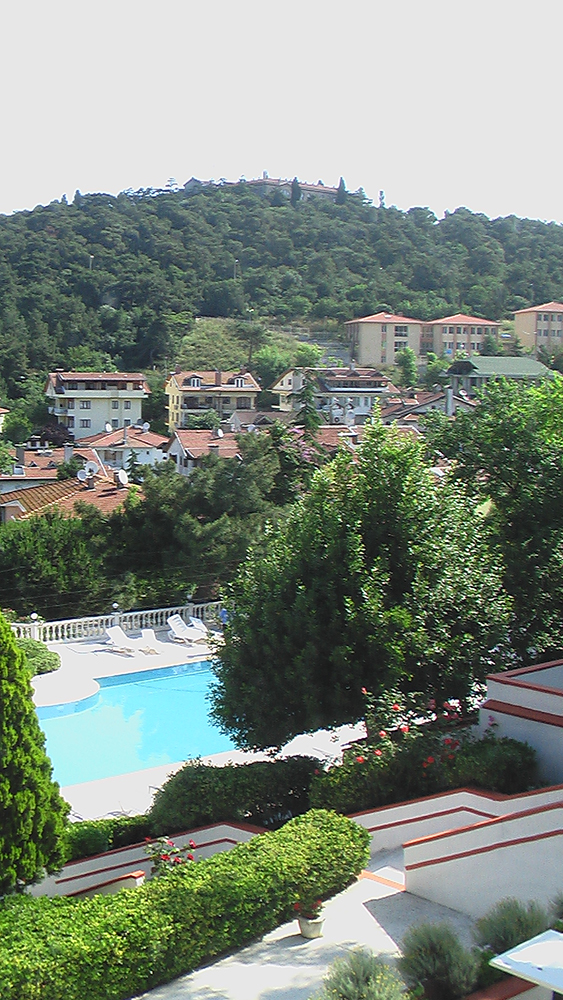
The afternoon included a scheduled tour of the Greek Theological School and Holy Trinity
Monastery, which is located up a very steep hill on Heybeliada. We were given a tour
and lecture on the history of the Monastery by Father Ephraim who is the only remaining
monk there. We were allowed to visit the chapel, and also sat in the antique wooden
desks in one of the former classrooms. The highlight of the tour was the research
library which included room after room of the hundreds of books in many languages,
some dating back to the 1400's.
Later in the evening an outdoor performance of the Stockton College Theater Program
STONES FROM GOD (TANRI'DAN TASLAR), took place at the site of Heybeliada International
Sound Center. The cast of Jason Benjamin, Jaaron Boger, Allison Eisenberg, Lane Jackson,
Patrick Judd, Alex London, Sarra Mazur and Alice Servellon gave an amazing performance
of the original production by Pamela Hendrick and Tom Papademetriou. This special
performance included a few 'extras' who literally walked on the stage (street) during
the performance. Audience members from the local community, Symposium participants,
and a couple of the local dogs and cats that roam the streets of the island were all
very impressed by the oral histories as they were performed by the actors.
The evening concluded with a lovely dinner on the terrace at the Halki Palace, where
the Symposium was being held. At the conclusion of dinner we were treated to a concert
by members of the musical ensemble BOSPHORUS. The music was wonderful, and although
the songs were sung in Turkish the audience could feel the lyrics through the melodic
voice of vocalist Vasiliki Papageorgiou and the talented musicians who accompanied
her.
Needless to say it was a perfect ending to a very full day.
The last day of the Symposium Session V: Memory, Heritage and Cultural Presentation
II included a talk by Bruce Clark (The Economist), and Session VI: Monuments and Travel
in The Ottoman Realm included a joint paper presented by Stockton College students
Lillian Hussong and Leticia Ramos. Upon conclusion of the final sessions, Tom Papademetriou
acknowledged all the participants thanking them for their contributions to the Symposium.
He also acknowledged the enormous amount of work done by Co-chair David Roessel.
In addition, Tom sent a special thanks to the ARHU staff, and to all those whose efforts
over the past year contributed to the planning and to bringing the Symposium to fruition.
And, finally kudos were given to Pam Hendrick and Mark Mallett and Cast for staging
a very successful production of STONES FROM GOD on Heybeliada Island.
Shortly after the closing of the Symposium the Stockton group checked out of the hotel
and headed down to the docks to take the ferry to Istanbul. This leg of the journey
included transporting costumes, props, and the boxes used for the set along with all
the luggage.
After a very pleasant ferry ride, we docked in Instanbul ready to set-out on the next
part of our journey. Thankfully a van awaited for the luggage and transport of the
costumes, props and set to the second performance location. Those who did not go with
the van were fortunate to enjoy their first experience of Istanbul, taking the very,
very, very, very crowded tram to the hotel.
The remainder of the day allowed the group free time to visit the Sultan Ahmet Mosque
(also known as the Blue Mosque), explore the area nearby the hotel, or catch-up on
their rest before dinner.
Everyone in the group was excited to be in Istanbul and was looking forward to the
second part of our journey.
The group started the day with a tour of the Haghia Sophia (AYASLOFYA CAMI MUZESI),
which is one of the most beautiful buildings in Istanbul. The building is under various
stages of restoration, where parts of the ancient mosaics, which had once been covered
over with plaster, have been restored.
The remainder of the tour included spending time at the Hippodrome (Sultanahmet),
which included the Obelisk (Dikilitas) that was brought to Constantinople by emperor
Theodosius I in 390 A.D. for the decoration of the Hippodrome, as well as the Serpentine
Column (Burmali Sutun), which originally stood at the Temple of Apollo in Delphi,
Greece. The last stop on the tour included a visit to the Cistern, the vast, hauntingly
illuminated ancient underground water system. Among the many ancient columns are two
columns where the base is an upside down head of Medusa, while on another column just
adjacent is another Medusa with the head is positioned sideways. The channels just
seemed to go on forever in an endless maze of water and columns of various sizes and
designs. . .
The highlight of the day was the final performance of STONES FROM GOD at the Zappeion
Greek Girls High School, which is located near Taksim Square. Principal Despina Rapine
Philippou welcomed the audience and cast to the school, including The Counsul General
of Greece, Vasileios Bornovas. Tom Papademetriou also extended an acknowledgment of
Stockton's gratitude for the opportunity to perform at the school, and introduced
Pam Hendrick who provided a brief explanation of the style of theatre performance
known as 'chamber theatre' or 'story theatre' that would be the format for the evening's
performance..
The cast of Jason Benjamin, Jaaron Boger, Allison Eisenberg, Lane Jackson, Patrick
Judd, Alex London, Sarra Mazur and Alice Servellon outdid themselves and presented
the audience with a relaxed and very memorable performance. Without a doubt the success
of both productions and the fact that many of the overall details went seamlessly
was due to the work of Joe Heim, who served as Stage Manager, and overall "wrangler
in chief". Mark Mallett's role as Scenic and Lighting Designer evidenced the level
of creativity and thoughtfulness that was required to adapt and successfully mount
the production in Turkey.
The oral histories told by the characters were very real and meaningful to several
of the members of the audience, including Principal Despina Rapine Philippou who spoke
of her own family history. After many group photos were taken, a brief reception was
held at the School. Principal Despina Rapine Philippou shared a brief history of the
School, noting that this year they were celebrating its 135th anniversary. During
the reception the Stockton group was presented with four tea settings that had been
designed with the School logo commemorating this historic anniversary. Following the
reception everyone in the Stockton group shared dinner at a wonderful Turkish Restaurant,
Haci Baba, which was hosted by the Consul General of Greece, Vasileios Bornovas. It
was a most memorable evening and enjoyable for everyone in attendance, but, especially
for the students. Needless to say a good time was had by all including the waiters
at Haci Baba.
The highlight of the afternoon, especially for the students, included a visit to the Spice Bazaar and ended with a shopping spree at the Covered Bazaar, which can make one feel like a kid in a candy store, as there is just so much to choose from. The remainder of the day included free time for dinner and packing for the scheduled 6am departure to the airport the next morning.
At 5:45am Tuesday morning all of the students were waiting in the hotel lobby, surrounded by their luggage ready to depart, but wishing they could stay just a little while longer. Although they were all very tired, they agreed to indulge me one last time for a group photo :)
I would like to add a personal note of thanks to Dean Gregg, David Roessel, and Tom Papademetriou for offering this wonderful cultural and historical experience to our students. It was great to hear the students commenting on a course that they had taken in relation to a particular historical site, and witnessing their excitement that they were actually able to experience the history and culture firsthand.
I would also like to thank them for affording me the opportunity to make a small contribution in planning the trip, attending the Symposium, and most of all for the opportunity to engage in a meaningful way with our students and faculty. As always, it was a pleasure working with Pam Hendrick and Mark Mallett as well.
The benefits from this experience have been great for everyone who participated. Tom and David are to be commended for bringing the vision of their idea for a Richard Stockton College Second International Symposium to a very successful outcome.
Each of us who took part in the experience took something special away. This page features images and thoughts from people who were there. Click on a name from the list below. The images (where provided) are those of the writer and are used by permission.

When I was a junior in high school, I had the opportunity to take a class called AP World Art History. I was hesitant at first—subjecting myself to forty minutes worth of agonizing slide transition clicks was not how I wanted to spend a whole year.
I was lucky to have a knowledgeable teacher who wanted everyone to take away something from the class—one painting, a sculpture, or an architectural masterpiece that that amazed us, and brought a deeper appreciation to art and history. As he worked his way through the time periods, I gradually became amazed by the works of geniuses so many centuries before me. My teacher brought to life pictures of churches and sculptures of gods and goddesses. He opened a door that I walked through eagerly to learn more.
For me, that one special slide in the class was of the Hagia Sophia. My teacher showed us how the light shone through the building and illuminated the place in such a way that could make a person fall to their knees in awe. He pointed out the roundels, larger than life calligraphic depictions of Allah, and the Caliphate, as it was when the Hagia Sophia had been a mosque. What a connection between two faiths to have shared the most beautiful building on the planet! I vowed from the day I saw that slide that if there was one place I had to see before I passed away, it would be the Hagia Sophia. I wanted to see the building that Justinian had so famously proclaimed to have built better than Solomon.
In April of 2010 I had received an eMail from a professor of whom I had heard, but never met. The message said that Professor Papademetriou wanted to meet with me, and if possible, I should come as quickly as I can. My mother called and practically shouted at me to meet with him that very instant (professors have a weird connection where they know things before I do), so I did. I walked in the door a little apprehensive, introduced myself, and sat down. Professor Papademetriou explained to me that he was attending a conference and was interested in having someone assist him. How many languages did I know? How much research work had I done? I was definitely a little frazzled because he sounded like he was looking for a world class worker, and I wasn’t too confident in my capabilities. He then indicated that there was a chance I could travel with him to this conference—in Istanbul. It was not one lightbulb that flashed in my head, but maybe ten thousand. Istanbul? The city of the Hagia Sophia? Located at the crossroads of European and the Middle East? There was no way I was going to be able to feel remiss about my academic capabilities—I knew that to get to Istanbul I would have to do a lot of hard work, which I was more than eager to do.
Fast forward to my arrival in Istanbul. As we walked around Sultanahmet Square to get to our hotel, I was in complete shock. There I was, in between the Sultanahmet Mosque and the Hagia Sophia! I felt very small next to these colossal buildings. But as small as I felt, my excitement was larger than those two mosques combined. It was almost as if what I saw wasn’t real. I am used to living in a dull town staring at no architectural marvels, and here I am in Istanbul and I feel like I need to rub my eyes so I can the street I live on, not the “eighth wonder of the world”.
The afternoon I went to the Hagia Sophia was truly life-changing. I was so nervous, as if the building could be judging me instead of me judging it. I walked inside with two friends, and we looked at some mosaics and informational posters for a few minutes (much to my hopefully concealed impatience). When we walked into the center of the church-mosque, I think all sound escaped from the place. It was me, and this church, and no one else around. I looked up at the dome, completely entrenched with light and calligraphy, and I began to tear up. In a strange way I cannot explain, I felt home. It was as if everything I had been studying in high school, at Stockton, and in my leisure, was right here. I stood there for several minutes, my eyes tracing a circle around the beautiful light that illuminated the calligraphy which was so beautifully adorned. I tilted my head to one corner, and there it was—that familiar ray of sunshine beaming into the place, casting a radiating energy which everyone soaked up. I really couldn’t believe it. And on the walls were those roundels, truly larger than any writing I’d seen before, in magnificent shades of gold and blue, challenging you to find anyone who could be as more loyal to a faith than anywhere else.
Having to walk away from the Hagia Sophia was hard, but I walked away thinking that I had seen the pinnacle of civilization. I still believe there is no finer structure on this planet than that church-mosque, and I do not think one will ever be built. I walked away with feelings of gratitude to two entities—first, those who built the Hagia Sophia and for having created it so that it will remain forever, and second—to Professor Papademetriou and all of Stockton College who made this trip possible. Like standing in the center of that place and not having true words to describe the experience, I have not enough words to describe my deepest thanks and appreciation to the people who believed in my capabilities to do research, and for all of Stockton having put together so marvelous a trip. The Istanbul Symposium has done for me more than I believe to know at this point in time. However it has instilled in me the confidence to keep doing scholarly research, and the wanderlust to go back to Turkey one day and once again agree with Justinian that he has stepped into a building more beautiful than one can fathom.
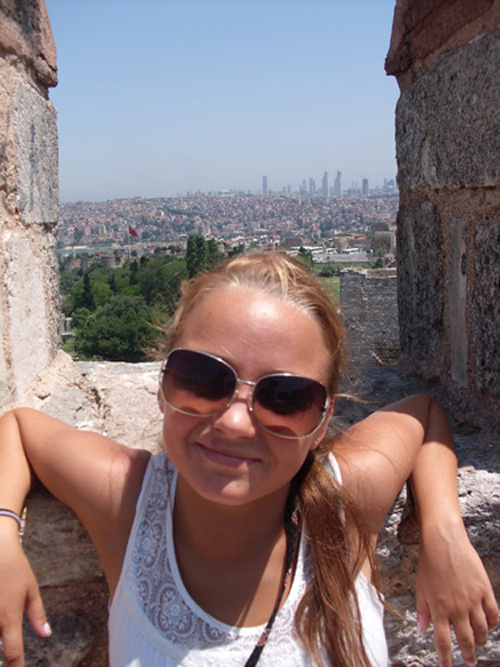 Heybeliada was a beautiful island. The locals welcomed us with open arms to their
humble homeland…as did their pets. There were friendly, affectionate cats and dogs
everywhere! One man claimed that there were nearly 5,000 cats inhabiting this tiny
“saddlebag” island! One of our first days at the Halki Palace, we had a few hours
to spare and decided to explore. As the group of students went along the roads, up
and down quite a few hills, we soon realized we had a follower. As soon as we acknowledged
his presence, our follower immediately became our tour guide. We followed our black
and white mutt friend as he gave us the VIP tour of his stomping ground. We found
some pretty cool sites including a few swanky boat docks, a Turkish Navy training
site on the back of the island, and a trail leading into the wooded area on the hill
of Heybeliada. There, we met a group of boys, no older than 15, who practically offered
us their entire picnic they had packed for the afternoon. There was a major language
barrier but it hardly mattered, we had so much fun with them! They were comparing
us to a few pop culture icons they knew about including Justin Timberlake. Hepe (the
name inherited by our new K9 friend), sat by contently as we ‘conversed’ with the
locals. That night and the days to follow, we ran into Hepe everywhere! He seemed
to pop up at the most opportune moments and responded to his name several times.
Heybeliada was a beautiful island. The locals welcomed us with open arms to their
humble homeland…as did their pets. There were friendly, affectionate cats and dogs
everywhere! One man claimed that there were nearly 5,000 cats inhabiting this tiny
“saddlebag” island! One of our first days at the Halki Palace, we had a few hours
to spare and decided to explore. As the group of students went along the roads, up
and down quite a few hills, we soon realized we had a follower. As soon as we acknowledged
his presence, our follower immediately became our tour guide. We followed our black
and white mutt friend as he gave us the VIP tour of his stomping ground. We found
some pretty cool sites including a few swanky boat docks, a Turkish Navy training
site on the back of the island, and a trail leading into the wooded area on the hill
of Heybeliada. There, we met a group of boys, no older than 15, who practically offered
us their entire picnic they had packed for the afternoon. There was a major language
barrier but it hardly mattered, we had so much fun with them! They were comparing
us to a few pop culture icons they knew about including Justin Timberlake. Hepe (the
name inherited by our new K9 friend), sat by contently as we ‘conversed’ with the
locals. That night and the days to follow, we ran into Hepe everywhere! He seemed
to pop up at the most opportune moments and responded to his name several times.
The day of our first performance on the island, the police had taped off our performance space, which essentially was a construction site. I was so enthused to be performing amidst the people in their space; on their turf. Watching it all happen around me as I acted it out was such a rewarding experience, something that could never be duplicated. As the play went on, we saw the audience growing larger and larger. Passersby would stop, grab a chair, and watch. Nearby homeowners were opening their windows so they could peer out and get a glimpse of the action. As the crowd grew, so did the number of people who disregarded the police’s attempt to block off our ‘stage’. Young children would run across, other women coming home from the market would walk right through our performance area. I assume some locals did not accept the fact that their daily route was altered, so they simply would not succumb to the change. Our cast didn’t miss a beat despite the hubbub; many of us enjoyed the fact that this new challenge was brought our way! As the play came to a close, the last few lines were being spoken. We were all in a state of genuine sincerity and utter appreciation for what this culture, that we were now experiencing first hand, had brought to the table for us. I couldn’t help but notice the tears flowing from some audience members’ faces, and I suddenly became emotional myself. Just as I felt as though I was going to shed a tear, who comes running from the street, around our set, through our props, and jets passed the cast during our last few words? Hepe! He had showed up at the most inconvenient time but nonetheless, made that particular show all the more truer and authentic. Not everyone saw his brief appearance but those of us who did where overwhelmed with excitement when we got offstage. That was the last time we saw Hepe on that trip. What an awesome way to say goodbye to our new pal.
I would like thank everyone who made this amazing trip to Turkey possible. It was an experience I will never forget. I have learned so much being involved in Stones From God and was ecstatic to be able to share such a story with so many people. I look forward to working with these kind professors in the future at Stockton; it has been a pleasure! Thank you also to our friends in the Hellenic Society who made it all happen. The generosity that has been shown by the Hellenic Studies Department is unparalleled to any I’ve seen thus far. Cok tesekkur ederim!
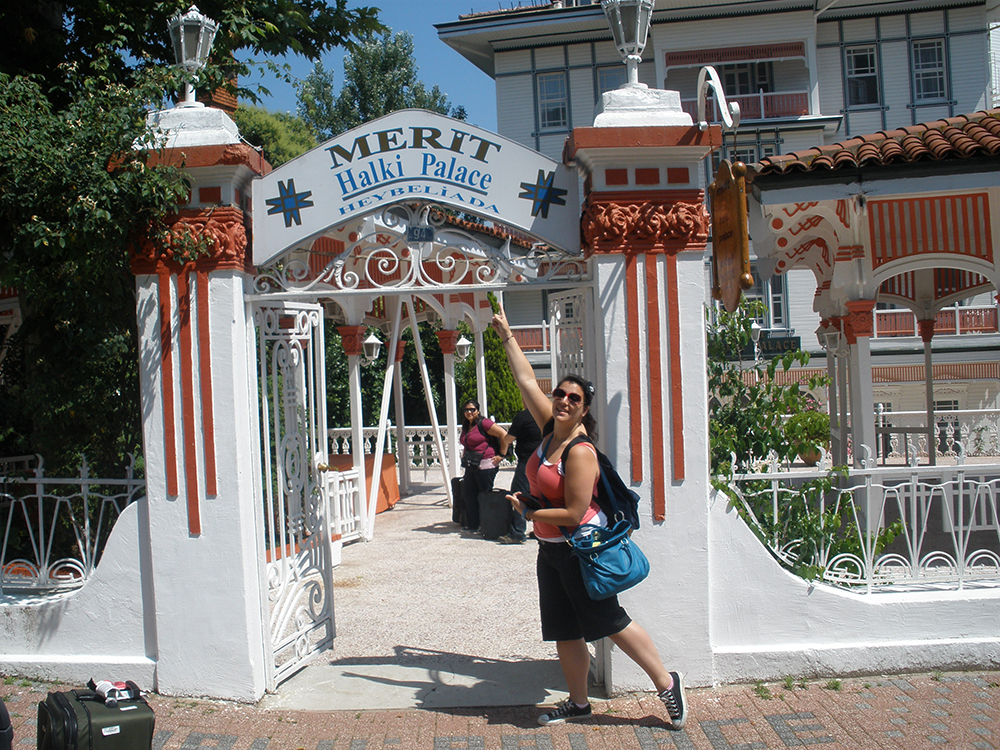
Istanbul will be my last memory from Stockton. It was the most majestic and awe-inspiring place I believe I will ever go for the rest of my life. Sunrise and sunset, which I saw several times over both the Bosphorus as well as the Aegean, was so beautiful, just thinking of it takes my breath away. Before I even learned of Stones from God and that it would be traveling out of the country, I had heard of only wonderful things from others who have traveled to Turkey. I can honestly say, no one lied to me. Turkey lived up to its word. Each Turkish person I met was so welcoming and wanted to just talk. In Istanbul, I was in a shop in the little bazaar by our hotel and I was invited in to have apple tea with the owner of the shop. Since, I had learned before I went on the trip that not accepting the invitation would be rude, I quickly accepted. He told me how badly he would love to travel to see America and show his children my home country. I honestly had no real pressure to buy by him. However, the Grand Bazaar is another story.
I cannot thank everyone enough who supported and allowed this life changing trip to take place. I traveled and performed internationally with Stockton to a place where the culture is so different from our own. I learned so much more than I had expected on that great trip. And I would like to add that since dining in Turkey, I have adopted a Mediterranean diet. The food literally changed my life!
They had everything and anything anyone could want and each shop worker always claimed he could give you the best deal. We spent four hours in the bazaar and I probably could have spent four more exploring. My favorite moment that I remember from the trip is the day that everyone from the Symposium including the speakers as well as the cast traveled on the Bosphorus to another island where we were to visit the (Saint) George of the Bells monastery. I had the best doner (chicken in pita with lettuce, tomato, tatziki and french fries) on that island. We took a horse drawn carriage to the middle of the hill and from there, we had the option to take a donkey up or walk. I chose the donkey because well, when will I ride a donkey up a hill in Turkey again? It was beautiful. I can still picture the clear water and rows of homes that we could see from the hill to the other side of the island. Finally, we made it to the monastery where George was our impromptu tour guide. The monk there gave us a bell as a gift to take home. The paintings were amazing and the fact that people still use it, was very moving to me.
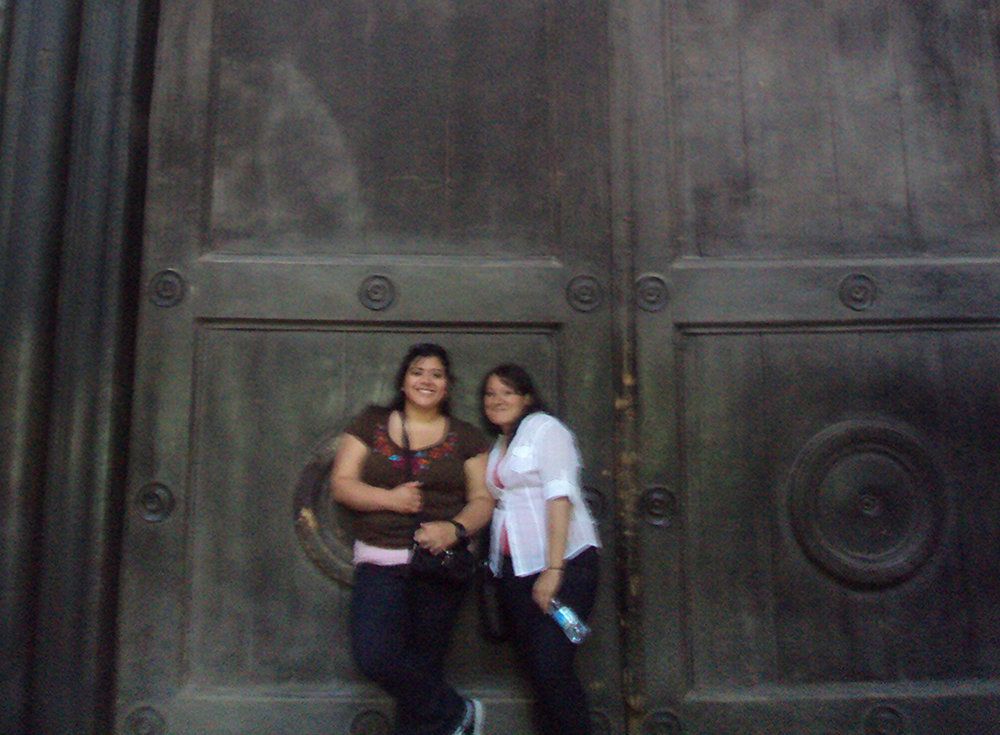 There is no possible way to sum up my experience on this past trip to Turkey. It was
one of those moments that will forever stay with me. There was so much to take it
at one time. The symposium was interesting. I learned a lot from the presenters, and
it opened my mind to other fields and topics that I was either unaware of or did not
pay too much mind to. I was afraid to present my portion of the research that Lillian
and I had done for the symposium. Being part of the symposium was both a memorable
and exciting experience. One of the highlights of the trip for me was the chance to
visit the Hagia Sophia. It was one thing to learn about the Hagia Sophia. I had learned
about it, learned about its importance, even learned about some of the arguments that
have taken place there. Yet, to walk around the Hagia Sophia, see both the Christian
and Muslim influences, and to see the beauty of the place was amazing. Pictures and
textbooks do no justice for this place. I would never have thought to get the chance
to see this remarkable place that holds importance for both cultures. It was definitely
one of those beyond amazing moments. One of my other favorite moments was shopping
in the bazaars. It was definitely a brand new experience to walk and shop through
a bazaar. It was chaotic yet I would not have expected anything less. It was exactly
what I picture in my mind after hearing so many stories about the bazaar. There are
so many things that I could talk about from the trip to Turkey, yet words do not seem
to be enough to describe it all.
There is no possible way to sum up my experience on this past trip to Turkey. It was
one of those moments that will forever stay with me. There was so much to take it
at one time. The symposium was interesting. I learned a lot from the presenters, and
it opened my mind to other fields and topics that I was either unaware of or did not
pay too much mind to. I was afraid to present my portion of the research that Lillian
and I had done for the symposium. Being part of the symposium was both a memorable
and exciting experience. One of the highlights of the trip for me was the chance to
visit the Hagia Sophia. It was one thing to learn about the Hagia Sophia. I had learned
about it, learned about its importance, even learned about some of the arguments that
have taken place there. Yet, to walk around the Hagia Sophia, see both the Christian
and Muslim influences, and to see the beauty of the place was amazing. Pictures and
textbooks do no justice for this place. I would never have thought to get the chance
to see this remarkable place that holds importance for both cultures. It was definitely
one of those beyond amazing moments. One of my other favorite moments was shopping
in the bazaars. It was definitely a brand new experience to walk and shop through
a bazaar. It was chaotic yet I would not have expected anything less. It was exactly
what I picture in my mind after hearing so many stories about the bazaar. There are
so many things that I could talk about from the trip to Turkey, yet words do not seem
to be enough to describe it all.
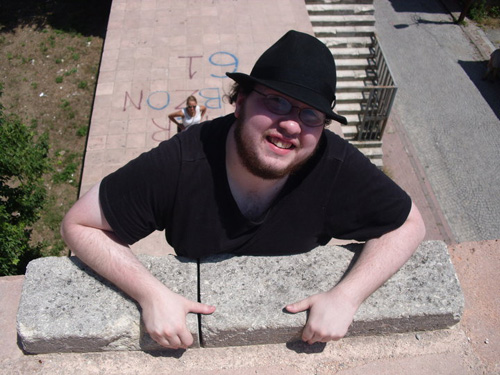 Seen here descending at an 80-degree angle the wisdom-tooth wide steps of the old
walls of Constantinople (to the breathless horror of the faculty below), Lane Jackson
is a recent graduate of Stockton. His involvement with Stockton's theater arts has
been extensive.
Seen here descending at an 80-degree angle the wisdom-tooth wide steps of the old
walls of Constantinople (to the breathless horror of the faculty below), Lane Jackson
is a recent graduate of Stockton. His involvement with Stockton's theater arts has
been extensive.
I am no longer a student at the Richard Stockton College of New Jersey. Done with
my undergraduate experience I am forced to look to my future with all its possibilities,
containing both its struggles and hopefully its successes. I am also inclined to look
back to the wonderful experience of my undergraduate career and the wonderful experiences
that have made me who I am today.
The Hellenic Studies are among the first I owe for my most powerful memories at Stockton. My first interaction with the Hellenic Studies was the production of the Odyssey. I was an actor and was able to be a part of the very insightful and meaningful discussion. Afterwards the discussion a member came up to me and talked to me for almost an hour about Hellenic Studies and I tried to take the lesson about claiming my own education to heart.
I owe them for both their support of the arts and for the dedicated work of several
faculty members who have personally helped both my endeavors and the endeavors of
countless students. The primary reason for this letter though is to right a wrong.
I was sent a year ago on one of the most meaningful events of my life. The entire
cast of Stones from God was sent to Turkey in order to perform and take part in a
convention. The purpose was the discussion of Greek culture that existed in Turkey
for hundreds of years and understanding the complex relationship between those Greeks
and the world around them.
The first response I had to this barrage of information and experiences could almost be compared to nausea. I couldn’t go three feet without learning something new all the while being surrounded by new sights, sounds and smells each competing for my attention. The sort of overwhelming knowledge that I stood literally at the conflux between my Western European background and another culture I had only read about was humbling. I remember most distinctly when the person to my left counted down from three and then informed me I was in Asia.
The small hotel we stayed at was the most hospitable place I had ever entered and I say that without exaggeration. The conference was a cornucopia of different theories and ideas all presented one right after the other. Even more interesting was the chance to meet these academics after the presentation when they were both far more relaxed and in all honesty far more talkative. I remember one night sitting with a woman who informed me that my perspective towards architecture and archeology was not simply wrong but criminal. The passion that she had for her field was more than intellectual but moral. So although I never had the chance to ask her name (she did frighten me) I still think about that conversation.
The performances both on the island and in Istanbul were unusual and powerful. Standing in the street while a group of men coming home from work stare at you all while wearing a bizarrely colored costume is a feeling hard to describe. It can perhaps be matched only by performing in a school of such historic significance while the Greek consulate watches. In the life of an actor every performance has meaning but those performances’ will always be different.
What else can be said? Each experience that the group for Hellenic studies allowed
for me and my fellow students was amazing in its own powerful variation. Whether spiritual
as we stood in the Agia Sofia or historical as we walked the walls of Byzantium. It
was personal in the cementing of friendships both new and old or introspective as
I spoke to people who I would never see again and who I knew would shape me.
The only regret I have and am now attempting to rectify was my inability to convey
to you, the persons who made this possible, my gratitude. Even this is a failure.
How do I thank you for the chance to walk with friends on the streets of a distant
land. Or the chance to find out I was not the haggler I thought, when I managed to
negotiate a hat from twenty all the way down to five lira. Only to discover the same
hat for sale down the street for one.
Thank you,
Lane McLeod Jackson
Professor Sacit Pekak of Hacetteppe University in Ankara, Turkey presented a fascinating look the abadoned churches of Cappadocia and the problems identifying and finding modern-day uses for them. His paper was entitled, "Ottoman Period Churches of Cappadocia."
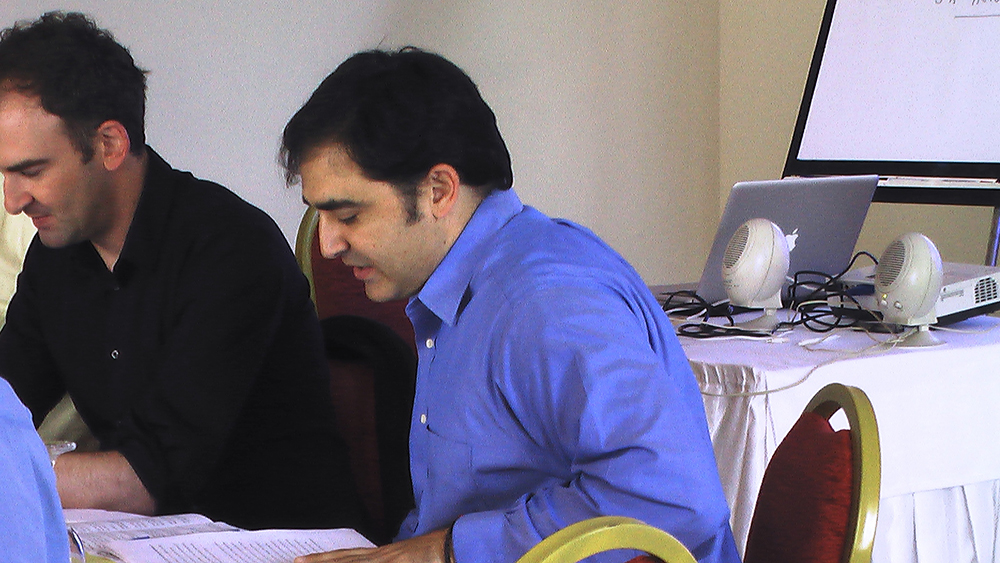
In addition to hosting and organizing the symposium and co-writing Stones from God, Professor Tom Papademetriou presented a paper entitled, "The Greek Orthodox (Rum Ortodox) Religious Culture in Ottoman Kayseri.
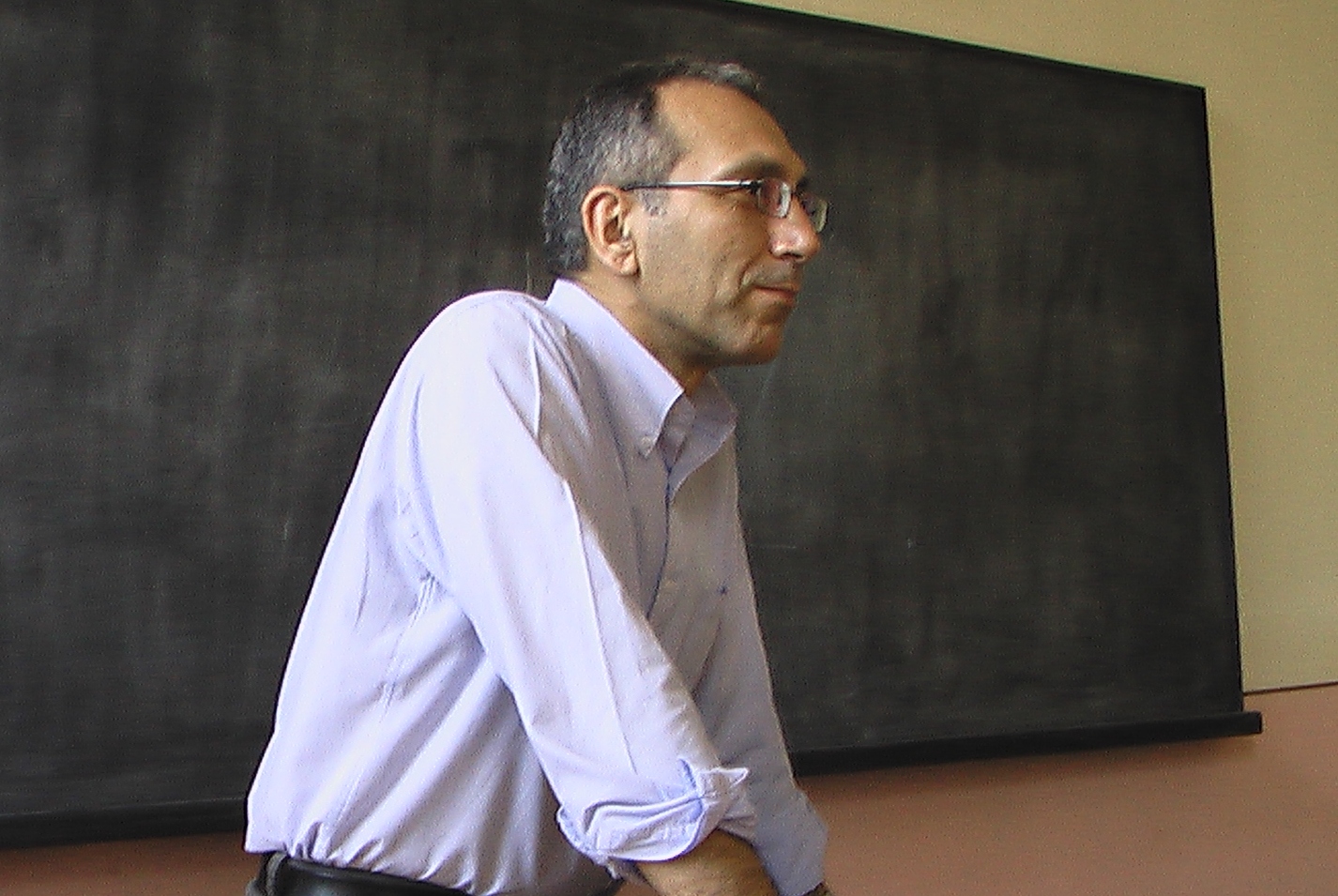
Professor Iosif Vivilakis of the University of Athens, in addition to editing and directing a staged reading of Auxentian Repentant, preseneted a paper entitled, "Orthodoxy and Heresy, Drama and Humor in the Christian East of the Eighteenth Century."
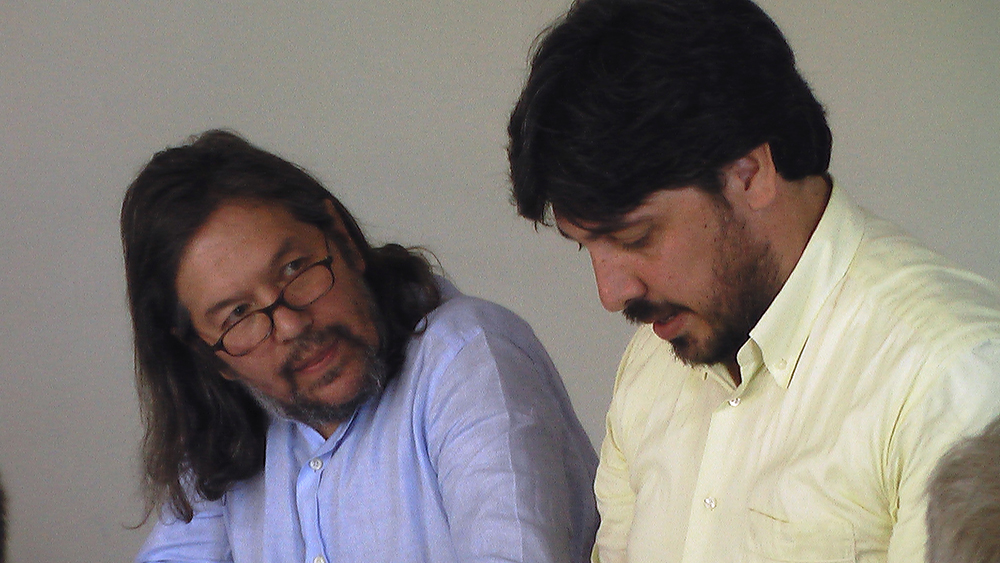
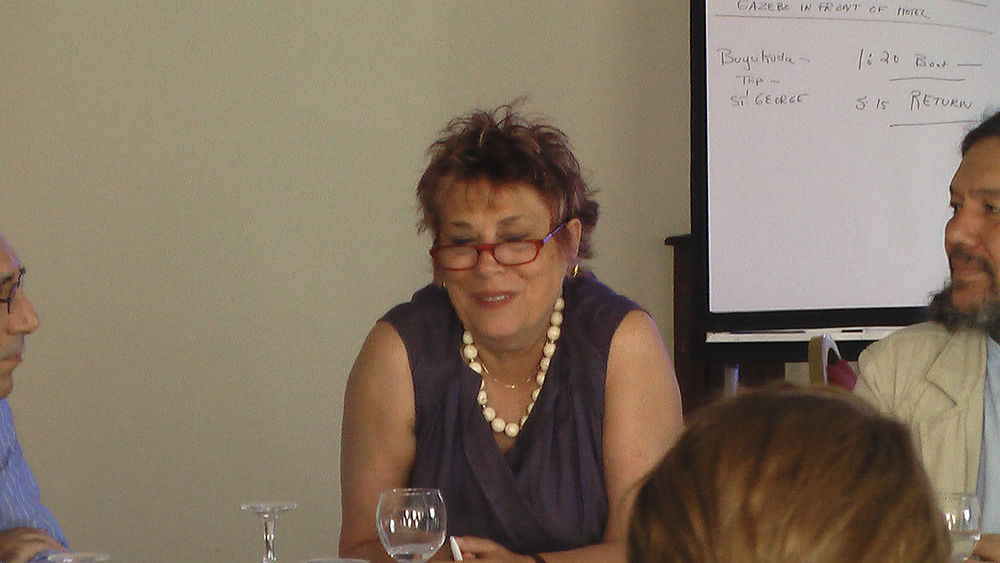

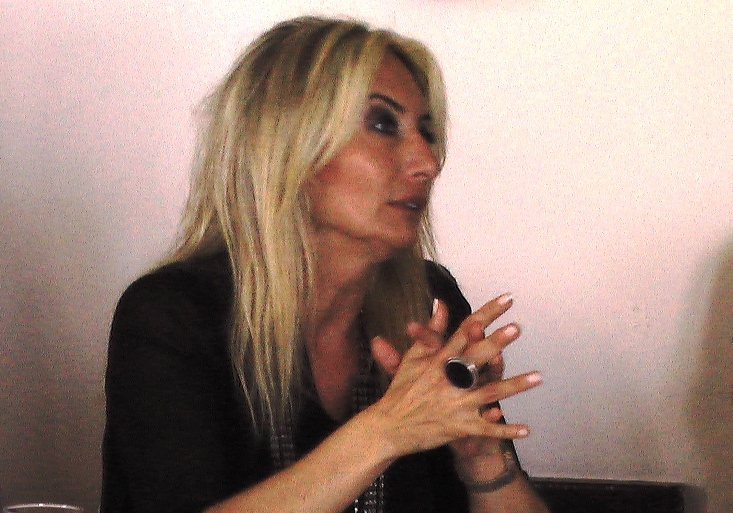
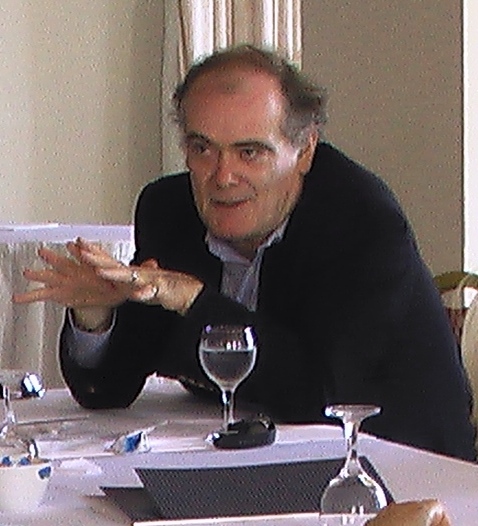
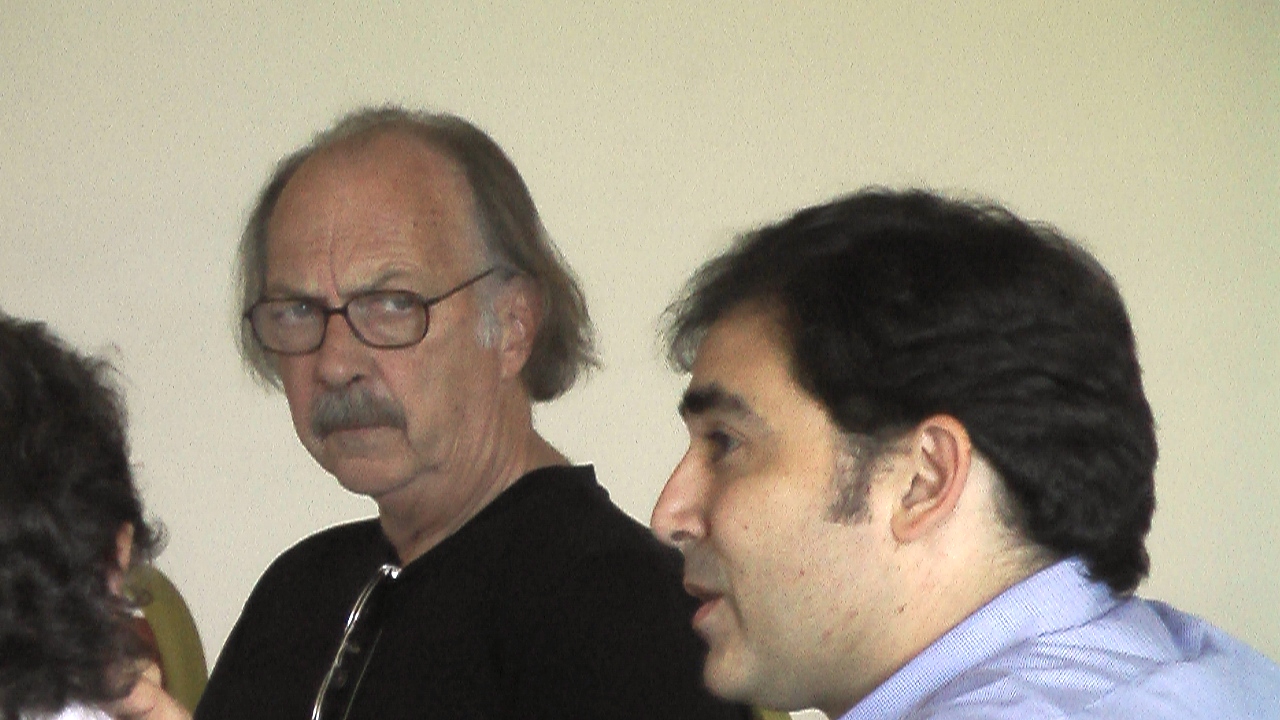
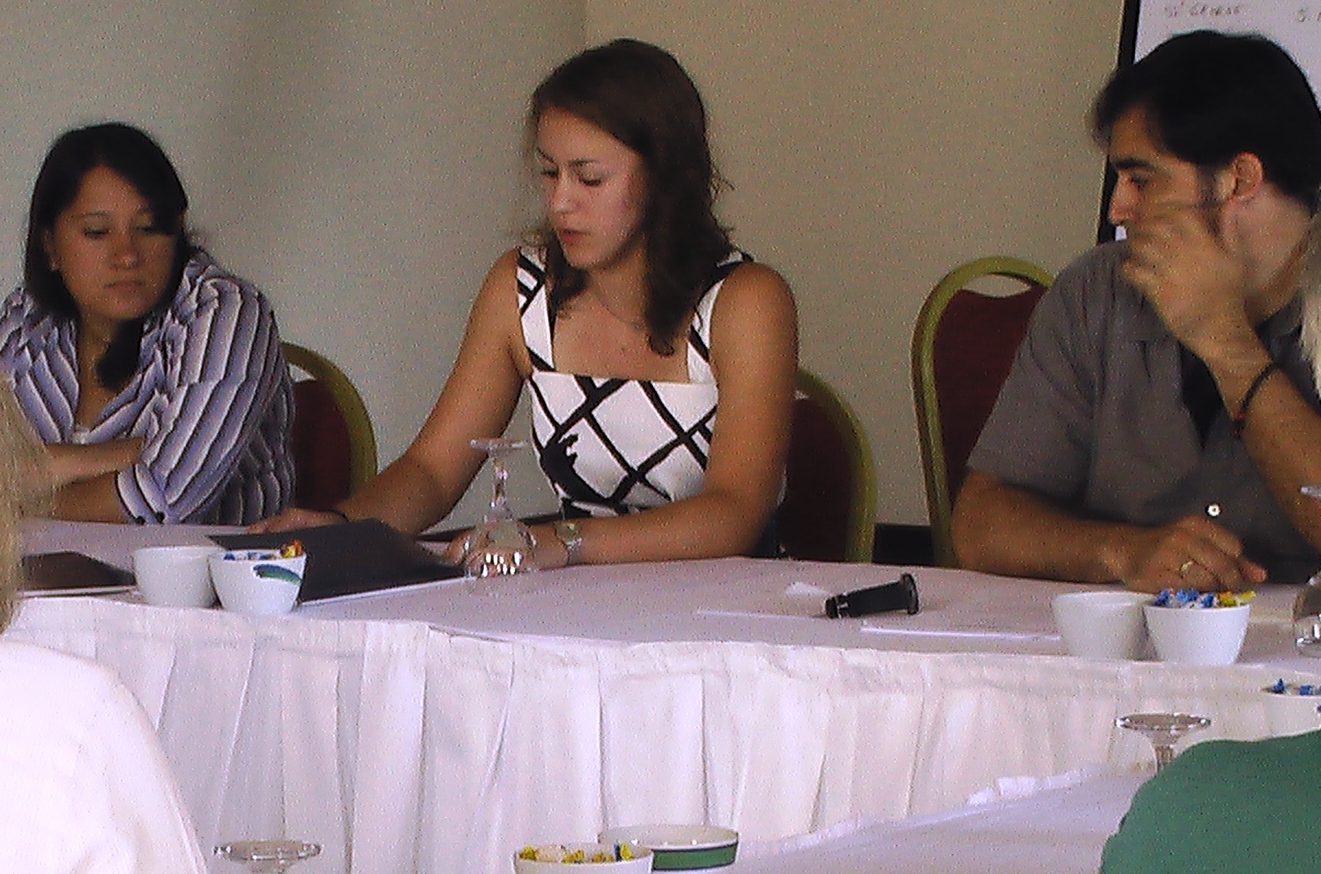
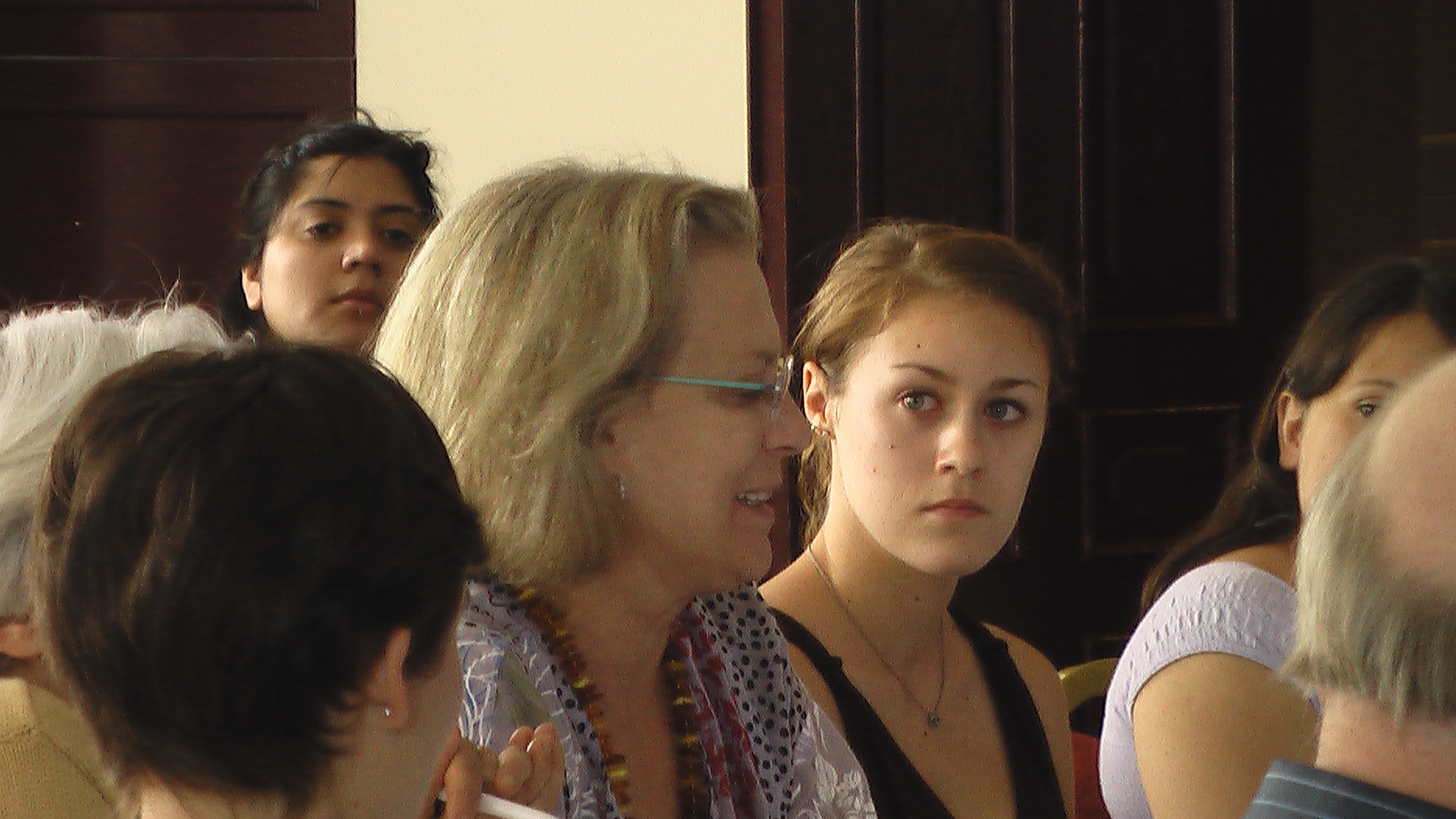
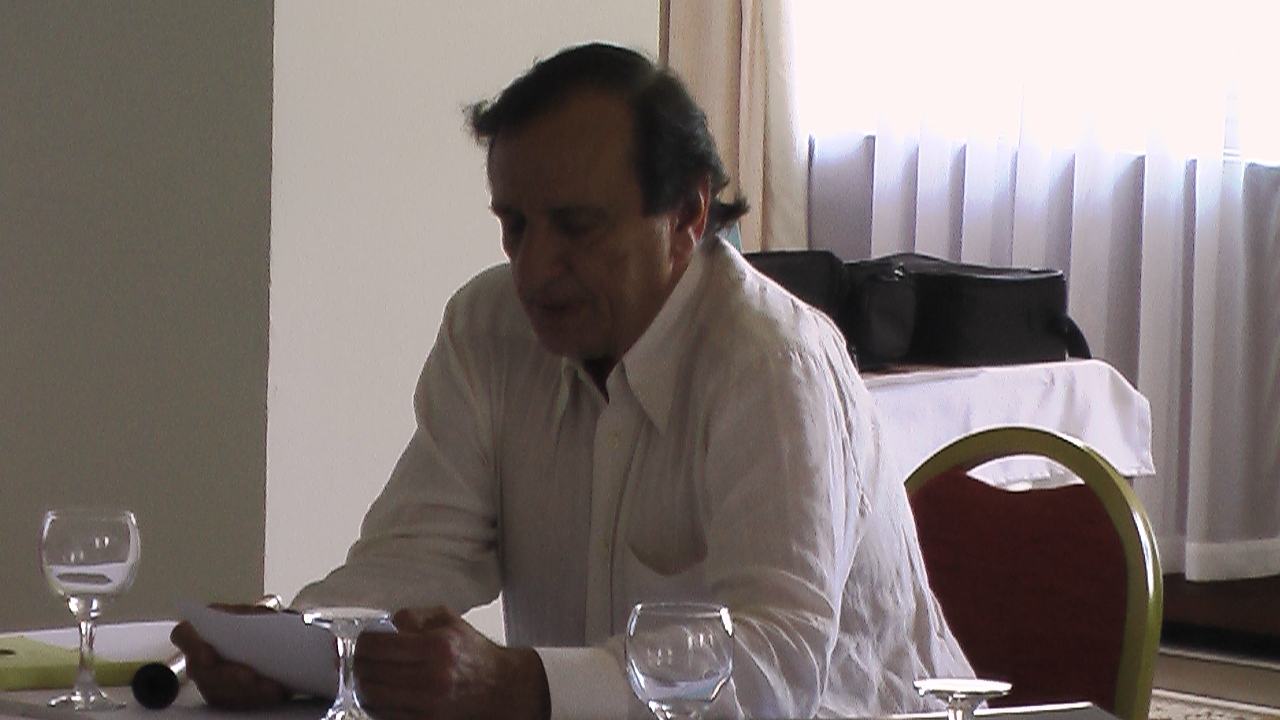
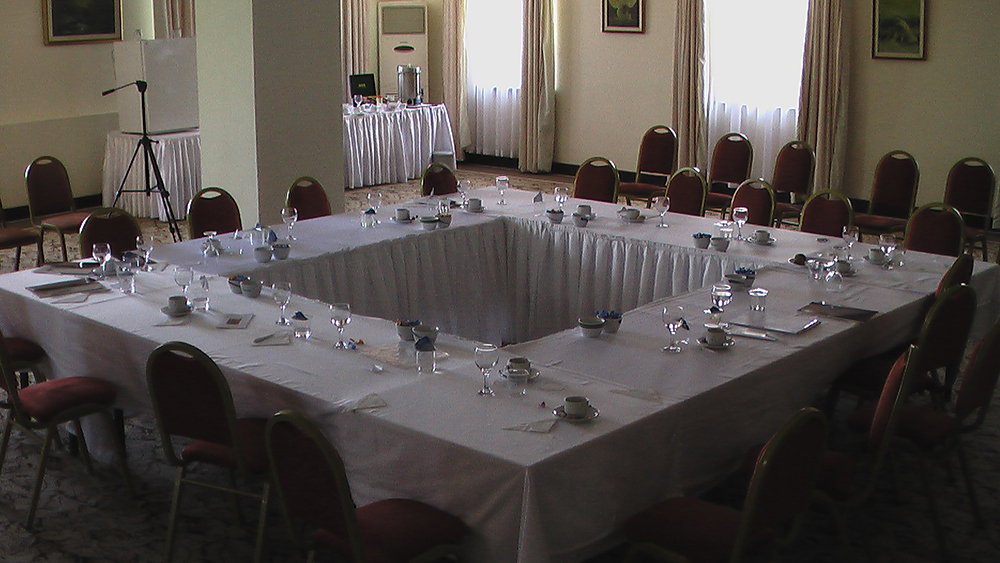
A fertile area for renewed examination is the religious culture of non-Muslims during the post-Byzantine and Ottoman era, particularly, when dealing with the subject of monuments and memory. An example of the most conspicuous non-Muslim monuments are Greek Orthodox (Rum Ortodoks) churches, that appear as a regular part of modern Turkey’s landscape, whether in Istanbul or in the Anatolian countryside. By their size and construction, it is often clear they are community buildings, built by people with real desires, fears, and hopes who placed these feelings deep into the bricks, mortar, timber and tiles of the structure. How these buildings came to exist depended on Ottoman imperial policies allowing for building and rebuilding of church structures. With the twentieth-century traumas, however, the churches often became silent, or at least no longer represented the purpose of the original community; serving now as mosques, warehouses, cinemas, stores, and even barns.
Examining the Greek Orthodox (Rum Ortodoks) religious culture during the Ottoman period is of great significance for 1) the scholarly study and preservation of monuments and material culture of these communities, 2) the study of confessional communities and historical memory and 3) the history of the Greek Orthodox (Rum Ortodoks) church in the Anatolian provinces. Therefore, the aim of this symposium is to examine Greek Orthodox (Rum Ortodoks) religious culture in post-Byzantine/ Ottoman Anatolia, with special emphasis on the following issues:
- Art and Architectural analysis of Anatolian churches
- Architects, Builders, and Patrons
- Religious/church history- Hierarchies (Patriarchate of Constantinople) and local churches
- Greek Orthodox (Rum Ortodoks) religious objects, practices and beliefs
- Culture and Syncretism (Religion, Music, etc.)
- Interrelations of faith communities
- Monuments, Preservation, Memory, and Recollections
- Tourism and its impact
- Research methods and practices (fieldwork, ethnography and archives)
It is entirely fitting that the theme of the symposium dealt with memory. With the
words of an impressive array of scholars, the 5am calls to prayer, the scent of doner
kebab, the stunning colors of stained glass windows, the silent bells of abadoned
churches, the patient monasteries, lonely candles, rocket-like minarets, disappearing
cultures, reappearing mosaics, timid donkeys and the unforgettably fearless taxi drivers,
our experiences in Istanbul, and everything we learned there, will remain with each
of us forever.
The music of Bosphorus and other performers can be found by clicking on secret panels. Find it and enjoy!
All photos by George Plamantouras
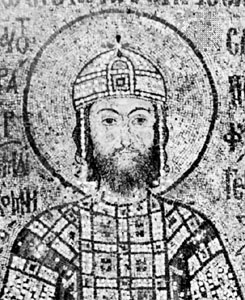
Tom Papademetriou, Ph.D.
Associate Prof. of Historical Studies
and Executive Director,
Interdisciplinary Center for Hellenic Studies
The Richard Stockton College of New Jersey
Jim Leeds Road
Pomona, NJ 08221
tel:609-626-6093
fax:609-652-4550
apapadem@stockton.edu
For information regarding the Symposium or any other ICHS matters, enquiries may be directed to: ichs@stockton.edu
